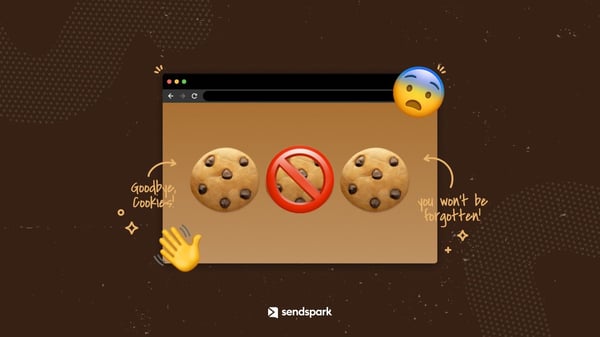Who doesn’t love cookies? Whether fresh from the oven or straight out of the cookie jar, a cookie is always a treat. Well, almost always.
For consumers who value their privacy, cookies are far more bane than bliss. But in this case, we’re referring not to the cookies you devour on a craving-fueled midnight raid of your kitchen cabinets. Rather, we’re talking about the kind of cookies that do the devouring themselves, eating up your digital data, principally for the purposes of tracking your online activities and reporting that information to businesses for marketing and sales purposes.
This kind of behind-the-scenes exploitation of your personal information has drawn the ire of critics, from individual consumers to government regulators, who repudiate the practice as an infringement on the consumer’s right to privacy. That’s why, in early 2020, tech giant, Google, announced that it would be phasing out the use of most types of third-party cookies on its browsers.
For marketers, though, the move is likely to produce more anxiety than applause, as many fear that the obsolescence of third-party cookies may well mean the loss of one of their most important marketing tools. This means that it is incumbent on marketing teams to maximize the effectiveness of the marketing tools that remain. Among the most significant of these is email marketing. Indeed, in the impending post-cookie era, effective email marketing will become more important than, perhaps, ever before.
The Rise and Fall of the Third-Party Cookie
Third-party cookies have been used for decades to track, archive, and sell information regarding internet users’ browsing habits. A purported goal of this practice was to facilitate targeted marketing and support a more personalized and satisfying customer experience. Above all, though, third-party cookies enabled commercial enterprises not only to build more accurate and comprehensive audience profiles but also to identify and access the most promising prospective customers for their business.
Critics of the practice argue that third-party cookies exploit consumers, essentially surveilling them and monetizing their personal information for the company’s gain. Perhaps most significantly, critics argue that these methods for collecting consumers’ personal data are opaque and disempowering. Consumers often have little understanding of or control over how their information is collected and used.
Google’s decision to phase out most third-party cookies was, ostensibly, designed to increase privacy on the web, to give consumers better control over their data, and to better conform with evolving industry standards, regulations, and practices.
Because these cookies were most frequently used by marketers and business leaders to connect with the target consumer and cultivate more effective outreach and relationship-building with them, the abandonment of third-party cookies means that marketers must use alternative methods to build and maintain customer relationships.
The Role of Email Marketing in the Post-Cookie Era
Whether you are a part of a large, established organization or you are helping to get a small startup off the ground, the marketing department is going to play an increasingly vital role in promoting business growth in this changed operating environment.
Now more than ever, proactive, strategic, and personalized outreach will be central to the success of your marketing efforts. Email marketing will be particularly essential in filling the gaps created by the cookie phase-out.
Because consumers are generally asked to consent to the receipt of marketing emails, it can always already be presumed that you have a viable prospective audience when you generate and disseminate a marketing email.
This means, though, that the first order of business when optimizing your targeted marketing campaign is to inspire your ideal audience to consent to receive marketing and promotional emails. Fortunately, there are myriad ways to draw prospective clients to your online content and earn their agreement to be contacted by your company.
Two particularly effective strategies for engaging customers in this way are social media marketing and SEO content development. Social media marketing is an ideal way to engage with prospective clients and inspire them to want to know about your business, products, and services not only through your social media posts but through customer-solicited bespoke content, such as email newsletters and marketing content.
Similarly, you can raise brand awareness, draw visitors to your website and social media pages, and generate leads through SEO content writing. This typically refers to blogs and other original content created by your marketing team and posted on your company’s website, social media pages, and other digital platforms.
When you’re on a limited budget, maximizing the value of the marketing resources available to you is key. You can use these tools much as you would once have used third-party cookies, to better identify and understand your market and then to use this understanding to devise highly engaging, personalized emails.
Creating Emails That Get Results
As crucial as it is to connect with prospective customers, your email marketing campaigns won’t generate the results you want unless you go the extra mile in ensuring that your content stands out from that of your competitors.
Personalized videos embedded in marketing emails can be enormously effective at every stage of the sales cycle. More generalized videos can be a cost and time-efficient strategy for capturing the interest of promising prospects, while more individualized content can be created for established clients, as your understanding of and engagement with the client grows.
The Takeaway
The coming phase-out of third-party cookies presents a host of new challenges for business leaders and marketing teams. To weather this transition effectively, marketers would do well to optimize the use of email marketing campaigns. This would include leveraging the benefits of SEO content and social media to generate leads and engage audiences. Above all, this means creating memorable, customized email marketing content to capture and retain audiences.




